I spent most of the weekend of January 25-26 at Morrow Mountain State Park in Stanly County, just east of Charlotte. Saturday morning started with teaching a few chapters of Technician license manual at the RARS Tech class. Once that wrapped, I went home for a quick equipment costume change, picked up John K4EB, and we were off to the state park for the weekend!
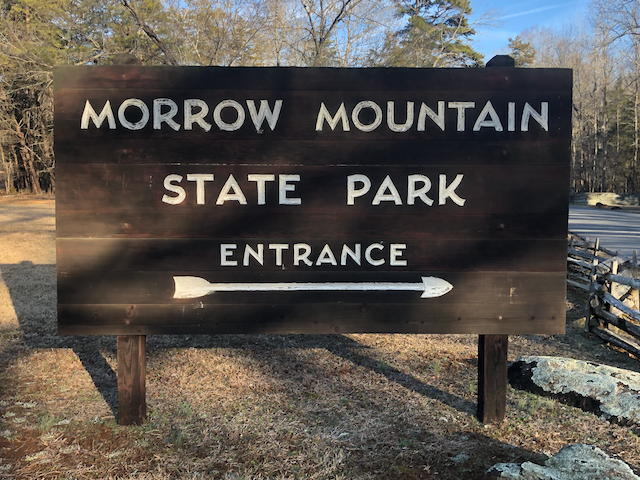
Our plan was for John to enter Winter Field Day (WFD) and I would enter the CQ World Wide 160m CW contest. When the 160m contest slowed down, I would jump over to Winter Field Day. By the end of the weekend, we would both put the brand new Pinecone Amateur Radio Club on the air in its first contests. All contacts made would also count towards our Parks on the Air totals.
Setup
Our accomodations were very good. We stayed in a “family vacation cabin” that had two bedrooms, a bathroom, kitchen, living area, and best of all, central heat! We moved the dining table out from the kitchen and into the living room to create two operating positions. This was an optimal arrangement for the weekend.
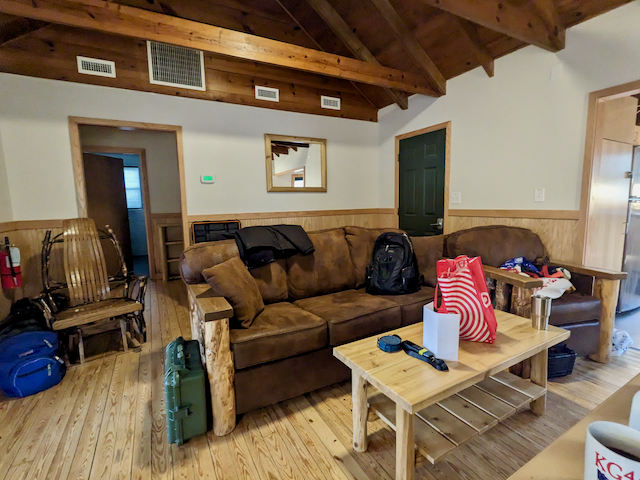 Cabin living area shortly after arrival.
Cabin living area shortly after arrival.
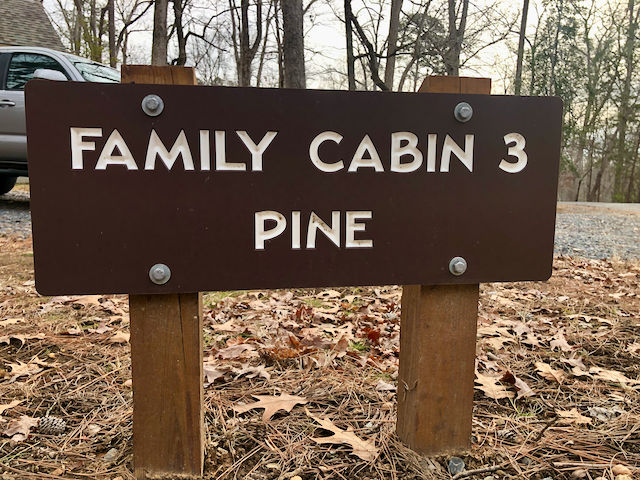 Cabin 3 has the fitting name “Pine” for the Pinecone ARC.
Cabin 3 has the fitting name “Pine” for the Pinecone ARC.
Once arriving, our first order of business was to make the best use of the remaining 1.5 hours of sunlight and put up antennas. My station used a quarter wave vertical on 160m and a 20m vertical whip for Winter Field Day. John used a 40m dipole for the duration. We both used FTDX10 radios with N1MM+. We did not network the N1MM+ logs. Instead, John merged our WFD logs afterward the contest.
My quarter wave vertical was made from a MyAntennas EFHW-8010-2K antenna by disconnecting the aerial from the transformer and attaching a radial system. The picture below shows the “adapter” I created for this purpose from an SO-239 panel mount connector. The adapter has a 14 gauge solid wire jumper with gator clip to connect to the aerial. The radials have ring terminals that are attached to the adapter with machine screws, lock washers, and hex nuts.
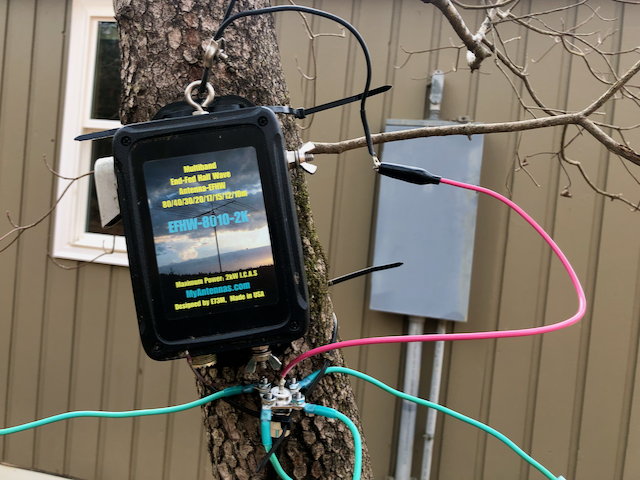 160m quarter wave vertical adapter for the otherwise 80-10m EFHW.
160m quarter wave vertical adapter for the otherwise 80-10m EFHW.
For the radial system, I used 17 gauge aluminum electric fence wire I bought from Tractor Supply on the way to the park. I bought a quarter mile of wire for ~$50 and made four 130’ radials. During this process, I learned that this wire is wild. It will twist and kink, has “memory,” and needs its ends to be anchored around a tree, with a rock on top, or a makeshift stake in the ground. Measuring, cutting, and placing the radials took an hour, and would have taken longer without John’s help.
The EFHW aerial has a loading coil 10’ from the feed point which helped shorten the overall length of the aerial. John put a beautiful line up a 90’+ pine tree to hang the antenna. We were unable to tell if the antenna curled around a tree branch at the top of the shot. If it did, it didn’t curl much.
Next, it was time to check the antenna on the analyzer. I was unsure of how a coil-loaded vertical intended for 80m would fair on 160m. However, my apprehension dissipated when I saw that the SWR at 1.8 MHz was 2.1. Although the resonant frequency of the antenna was 1.736 MHz (outside of the ham band), the FTDX10 was able to tune the antenna through 1.9 MHz (with SWR=4.4!).
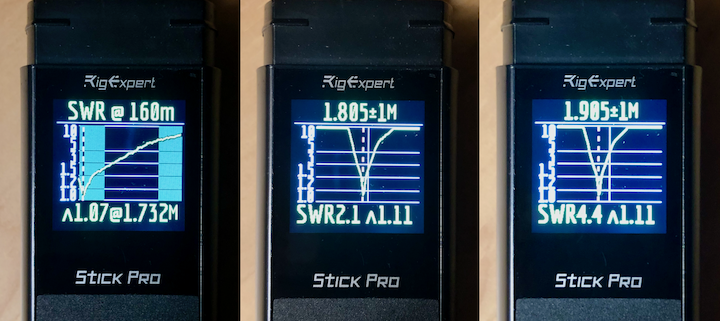 160m quarter wave vertical SWR.
160m quarter wave vertical SWR.
John used a resonant 40m dipole and put it 40’ in the air between two trees. The broadside of the dipole faced the EFHW. I noticed some interference on 160m during John’s transmissions, but I was able to avoid it by moving 20 kHz up or down the band. The FTDX10 radios are very good in multi-multi setups.
160m Contest Time
When it came time to get on the air, John was off to the races running 40m for Winter Field Day. I was elated when I plugged in my 160m vertical and saw a wall of signals in the lower portion of the 160m band. So close!
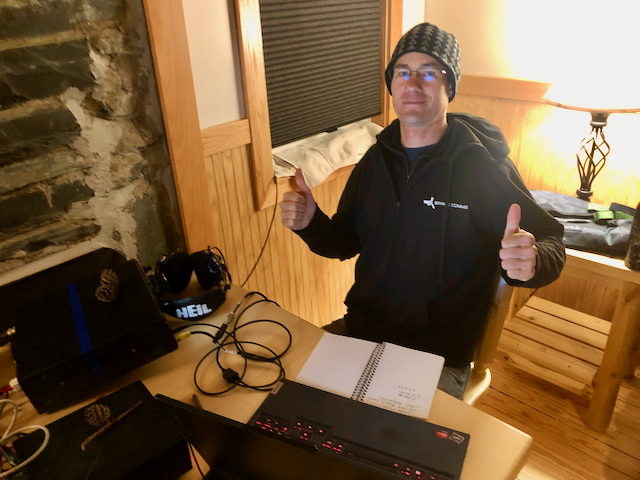 John K4EB operating Winter Field Day. Note the pinecones for good luck.
John K4EB operating Winter Field Day. Note the pinecones for good luck.
However, I struggled to put my station on the air. One mistake was forgetting a USB cable to connect the rig to the laptop. John loaned me his, since he would only be operating 40m SSB and wouldn’t need CAT control.
Then, while checking the antenna system, I connected my paddle directly to the radio to test. In my haste following antenna testing, I forgot to plug the paddle back into my WinKeyer and plug the WinKeyer into the radio. After correcting this issue, I found that N1MM was unhappy. The error messages were not helpful. From what I could tell, N1MM was unhappy with the order in which the FTDX10 serial port and the WinKeyer serial port were enumerated. While troubleshooting, I unplugged the rig and keyer, “uninstalled” the devices from Windows Device Manager, rebooted the laptop, and plugged them back in to reverse the COM port number assigned to them. This seemed to make N1MM happy. I estimate 1-1.5 hours lost between these two issues, with the majority of the time being spent on N1MM and multiple laptop reboots.
Once on the air, I started by searching and pouncing various 160m stations using my personal callsign, K4CBW. After making a few QSOs and taking a break, I came back to the 160m contest using the club callsign and made 54 QSOs. Following another break, I came back and used my personal callsign to run. It was then that I realized how difficult our club callsign is for DX stations. I had far fewer repeats using the my personal callsign than the club callsign (K4CBW vs. KR4AQZ). After having worked all the stations I could hear, I went to sleep around 3:30 AM.
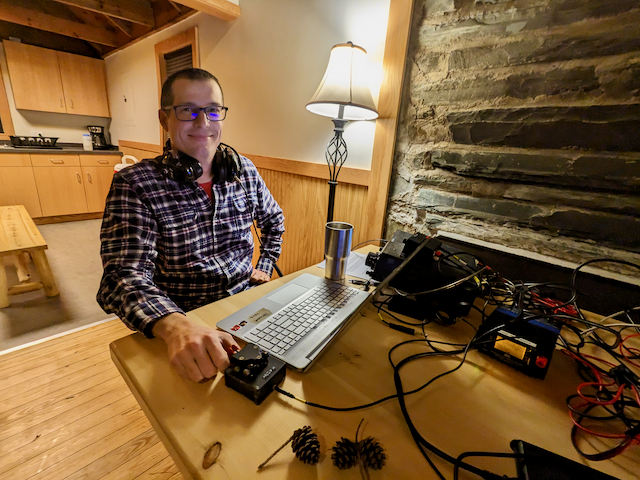 K4CBW at the key of the 160m station. Photo courtesy of K4EB.
K4CBW at the key of the 160m station. Photo courtesy of K4EB.
I woke up at 7:15 AM the following morning, made instant coffee, and jumped back on 160m with my personal callsign. I made 8 additional QSOs during gray line before the band closed down. At 8:50 AM, I was only able to hear four stations running, K3LR being the loudest.
N1MM Stats
Here are the statistics reported for the 160m contest reported by N1MM.
Score Summary
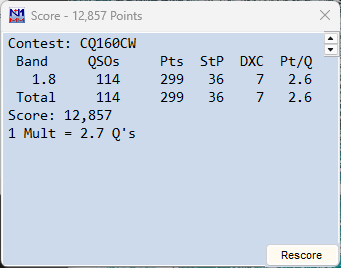
Runs
CQ World-Wide 160 Meter DX Contest - CW - 2025-01-24 2200Z to 2025-01-26 2200Z - 115 QSOs
K4CBW Runs >10 QSOs: for computer named: LAPTOP-BD1SUO76
2025-01-26 0639 - 0723Z, 1816 kHz, 69 Qs, 94.9/hr K4CBW
2025-01-26 0728 - 0740Z, 1824 kHz, 11 Qs, 56.1/hr K4CBW
Off Times
CQ World-Wide 160 Meter DX Contest - CW - 2025-01-24 2200Z to 2025-01-26 2200Z - 115 QSOs
K4CBW - Off Times >= 30 Minutes
2025-01-24 2200Z - 2025-01-26 0553Z 31:54 (1914 mins) (Start late)
2025-01-26 0755Z - 2025-01-26 1234Z 04:40 (280 mins)
2025-01-26 1238Z - 2025-01-26 1315Z 00:38 (38 mins)
2025-01-26 1346Z - 2025-01-26 2159Z 08:14 (494 mins) (End early)
Total Time Off 45:26 (2726 mins)
Total Time On 02:34 (154 mins)
WFD Contest Time
After 160m dried up, I ate breakfast and went outside and put up my 20m quarter wave whip and radials. However, the pace was slower than the 160m contest. I could tell a difference between the cadence and exchange efficiency between the 160m contest operators and the Winter Field Day operators.
I was determined to make 100 contacts on 20m CW. This took longer than expected. I wound up borrowing John’s antenna for a brief spell, working 40m CW, then tuning it on 15m, before returning to 20m to search and pounce for the last few to reach 100 QSOs.
Here is the N1MM score summary from my Winter Field Day operating. This does not include the QSOs John made.
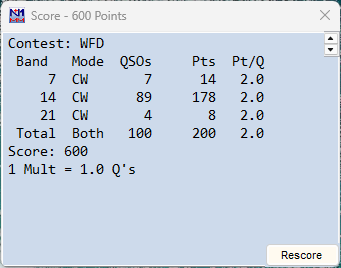
Tear Down & Pack Up
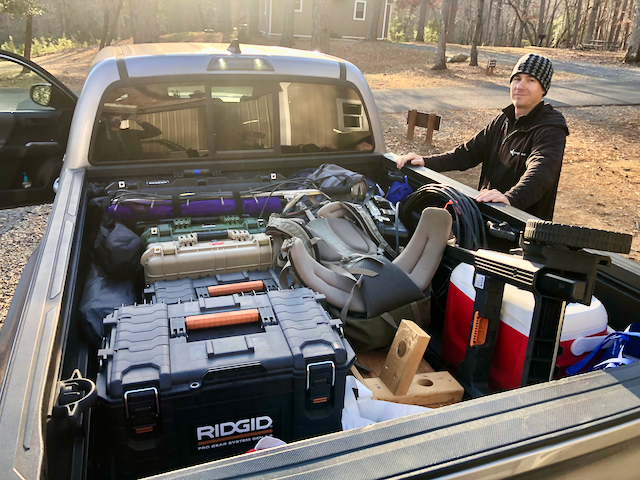 Loaded up and ready for home.
Loaded up and ready for home.
Post Contest
Within a week of submitting logs, I had 27 states and 6 DX entities confirmed via Logbook of the World (LotW). The DX entities were Belize, Canada, Cayman Islands, Curacao, Martinique, and the USA.
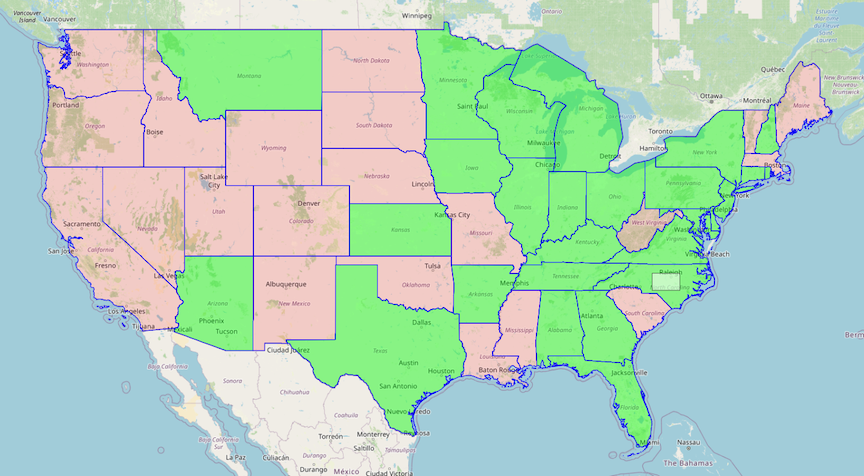 K4CBW 160m CW Worked All States (WAS) progress.
K4CBW 160m CW Worked All States (WAS) progress.
Future Improvements
- Use a single call per contest, not much point in submitting two half-logs.
- Test the computer, radio, and WinKeyer together BEFORE the contest.
- Position the EFHW antenna off the end of the dipole. It didn’t make much of a difference this weekend, but could in the future.
- Try trimming the radials to raise the 160m vertical resonant frequency.
- Operate through the night. Grab a 2-3 hour nap when things slow down, and resume operating before sun up.
- Plan the calendar better to start at the beginning of the contest.
- Take more pictures, especially of the cabin and operating positions.
For Field Day ‘25 at Morrow Mountain
- Bring clamp work lamps, a few big ones.
- Investigate peer-to-peer networking (no router) for N1MM.
- Bring a WiFi router to network the logging computers.
- Repair footswitch.
- Bring a longer stereo cable for paddles.
- Bring a butane soldering iron.
- Bring a balun for the 40m dipole?
- Bring a spare power strip.
- Bring varying lengths of RG8X, 100’, 50’, 25’, 12’.
- Bring station license and ERP calculations.
- For bathrooms, bring hand towel, hand soap.
- For kitchen, bring dish soap and sponge.